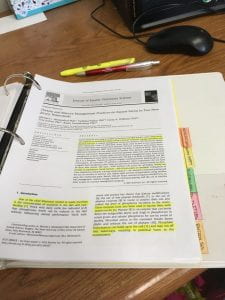Hello, and welcome to my internship blog! I’m Sydney Sill, the intern working on the Building a Horse Farm Improvement Program internship at the Cornell Cooperative Extension located in Saratoga County.
There is one word that sums up the experiences of my first week: familiarization. I became familiar with my new schedule, which currently is going into the office on Mondays and Thursdays, and working on assigned tasks remotely on Tuesdays and Wednesdays. While in the office, I was showed the layout of CCE department, introduced to all of the staff there (including one of their dogs!) and where any supplies I needed would be located. I also familiarized myself with the 30-minute commute there and back, including how to navigate through the three consecutive roundabouts right off of the highway exit without getting disorientated. On Tuesday and Wednesday, I also familiarized myself with how I could create productive work habits in my apartment without getting distracted, as well as the public places I could go such as libraries when distractions couldn’t otherwise be avoided.
Most importantly, I familiarized myself with the overarching goal of the internship: developing a program to evaluate and offer advice to horse farms in eight key pre-determined areas: horse health, human safety, biosecurity, nutrient management, manure management, facilities, business management, and sustainability. There was an obstacle in that my faculty advisor was away on vacation and has access to a previous intern’s work that my advisor at Saratoga County CCE doesn’t have access to. However, my CCE advisor and I were able to come up with some tasks that would still be beneficial even without having those resources. First, I had to write a bio of myself so that it can eventually be made into a press release for a Saratoga County CCE newsletter to inform local residents and horse farm owners of who I am and this program we are working on. Next, I was asked to create a barn safety checklist, which helped to familiarize me with some of the requirements that will be necessary for facilities and human safety. Finally, I was assigned to do a literature review on the eight topics mentioned earlier. On Monday, I created a binder and made eight sub-sections for each topic. Using the office printer, I printed out a ton of scientific papers pertaining to each topic. I spent much of Tuesday and Wednesday reading through most of them, and by Thursday afternoon, I felt I had a very good understanding of biosecurity and manure management, and a more general familiarization with the other topics. By the time I left on Thursday, I had written up a four page summary evaluating what biosecurity was, sources of diseases on horse farms, and biosecurity measures. I grouped these biosecurity measures into absolutely necessary (ex. quarantining horses with contagious deadly diseases from healthy horses), advisable (have visitors wash hands before interacting with horses), and too impractical to realistically implement (undergoing a footbath to sterilize boots between interacting with different horses when there are no suspected ill horses). I also had about a page on manure management. It appears that NYS does not currently have explicit regulations set in place for small horse farms in regards to manure management. They only have the general regulation that if a farm is found to cause a water quality violation, they can be subjected to regulations to resolve that. This differs from our neighboring state NJ, which has explicit regulations such as requiring stored manure to be located at least 100 feet away from wetlands and waterways.
It looks like for next week, I’ll be working on continuing to write a summary for each of the topics.



Hi, this is a comment.
To get started with moderating, editing, and deleting comments, please visit the Comments screen in the dashboard.
Commenter avatars come from Gravatar.